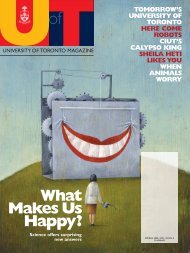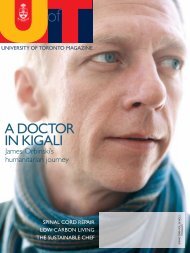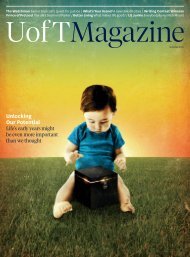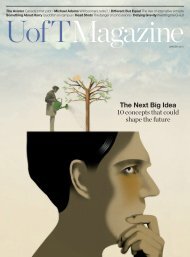Continued <strong>from</strong> page 37Each year, about 8,500 studentsplay intramural sports, participating ineverything <strong>from</strong> triathlons <strong>to</strong> table tennis.While some <strong>of</strong> the teams play ata varsity level, there are divisions for alltypes and abilities – inner-tube waterpolo, for instance, for students whoneed help staying above the water-line.Anne Richards, one <strong>of</strong> the ninesleepy-looking specta<strong>to</strong>rs in the stands,is here <strong>to</strong> see her son Mark skate forthe engineers. “The teams only playfive games in a semester, so if you missone, you’ve missed a lot <strong>of</strong> the season,”she says. The late start time is finewith Richards: “It’s more convenient,actually,” she says, eyes on the ice.“This way, it doesn’t conflict withanything except sleep.”12:28A.M.Fiona Rankin studies a set <strong>of</strong>graphs scrolling across her computerscreen in the sleep labora<strong>to</strong>ry atthe Toron<strong>to</strong> Rehabilitation Instituteon <strong>University</strong> Avenue.The graphsmeasure the breathing patterns,heart rates and brain waves <strong>of</strong> threepatients. Rankin points <strong>to</strong> a longflat section in one graph.“This manessentially s<strong>to</strong>pped breathing fora full minute,” she says.Rankin, a technician, is workingthree 12-hour shifts this week.Most patients at Sleep ResearchLabora<strong>to</strong>ry have sleep apnea, acondition that can cause them <strong>to</strong>temporarily s<strong>to</strong>p breathing dozens<strong>of</strong> times a night. Heavy snoring isone indica<strong>to</strong>r <strong>of</strong> apnea. In Rankin’s<strong>of</strong>fice, three Fisher-Price babymoni<strong>to</strong>rs, one for each patient,emit a gentle rumble.“Did you hear that?” Rankin asks.“He started breathing again after81 seconds.That’s a very long apnea.”Dr. Douglas Bradley, a U <strong>of</strong> Tpr<strong>of</strong>essor and the labora<strong>to</strong>ry direc<strong>to</strong>r,is investigating how sleep disordersrelate <strong>to</strong> cardiovascular problems.In a recent study, Bradley and hisresearch team found a link betweensleep apnea and the risk <strong>of</strong> stroke.As for Rankin, she says that therewards <strong>of</strong> assisting with this type<strong>of</strong> research are high, but admits thatworking at night takes a <strong>to</strong>ll.“I havea lousy sleeping pattern,” she says.Information Commons, Robarts Library38 UNIVERSITY OF TORONTO MAGAZINE / SPRING 2006
1:07A.M.“In this lab, we study nema<strong>to</strong>de worms,”says Mariam Alexander, a second-yearmaster’s student in medical genetics. Sheand Alexandra Byrne, a third-year PhDcandidate in medical genetics, are usingthe tiny worms <strong>to</strong> determine how specificgenes affect muscle developmentand also how genes work <strong>to</strong>gether inthe context <strong>of</strong> a whole animal.Their lab is on the 12th floor <strong>of</strong>the sleek new Terrence Donnelly Centrefor Cellular and Biomolecular Research,which <strong>of</strong>fers a shimmery, nighttimeview <strong>of</strong> down<strong>to</strong>wn Toron<strong>to</strong> throughits floor-<strong>to</strong>-ceiling windows. On anygiven night, you’ll find a handful<strong>of</strong> masters and PhD students in this3:24 A.M.In a reading room at the RobartsLibrary,the students look either bored,desperate or deep in concentration.Several are completely unconscious.Mai-Ling Truong, Joey Ng andKristin Eberth are staked out at atable in the main lobby.They allhave looming deadlines.“I’m working on an essay onthe Indian Act,” says Truong, a secondyearAboriginal studies student.“It was due <strong>to</strong>day.”Ng, a fourth-year <strong>life</strong> sciencesstudent, is writing a book report aboutFilipino culture on the Internet.“It’s one <strong>of</strong> the most boring <strong>to</strong>picsever,” she groans.lab, completing experiments, crunchingdata and compiling results.“The worms have a three-day <strong>life</strong>cycle,” explains Byrne, so for studentsengaged in a complex experiment, thatmeans working <strong>to</strong> the worm’s schedule.“It’s a biological organism,” saysAlexander, “so it’s not like we can turnit <strong>of</strong>f and come back and continue theexperiment. The worm will die, andthen you lose everything.”Byrne and Alexander, who havebeen working in the same lab for abouttwo years, say the new Donnelly Centrelabs are a vast improvement over thewindowless rooms <strong>of</strong> the MedicalSciences Building, where they used <strong>to</strong>conduct research. “Here you can seethe sun rise and set,” says Alexander,“There’s actually daylight.”Eberth, a third-year politicalscience student, is supposed <strong>to</strong> be writingabout Quebec separatism for anessay that was due two days ago.“Myenthusiasm is unparalleled,” she says,while rolling her eyes.The three are no strangers <strong>to</strong>late-night work, although Eberthsays that the frequency <strong>of</strong> theirmidnight study marathons varies.“Sometimes I don’t work late atnight at all and sometimes five nightsin a row.” It may not be for everyone,but it’s a system, says Eberth, herfriends typing furiously beside her.“We don’t usually wake up until1 p.m., so this is our time.”2:16A.M.“This is why we don’t have anyglue sticks left,” sighs ClaudiaCalabro, edi<strong>to</strong>r <strong>of</strong> The Gargoyle,reaching up <strong>to</strong> pull an erranttube <strong>of</strong> hardened glue <strong>of</strong>f theceiling where an anonymousprankster has stuck it. Calabrois the edi<strong>to</strong>r <strong>of</strong> the Gargoyle,<strong>University</strong> College’s irreverent,<strong>of</strong>ten satirical and sometimesplainly juvenile newspaper.Tonight the paper’s staff isworking on its election issue.Part <strong>of</strong> the Gargoyle’s enduringappeal is its grungy, handmadelook, which comes <strong>from</strong>assembling it the old fashionedway – by cutting out picturesand text with X-Ac<strong>to</strong> knives andgluing them on<strong>to</strong> large sheets<strong>of</strong> paper.About a dozen studentstaffers are gathered around theconference table – an abusedbilliards table, with the snookerballs lumped in the pockets –<strong>to</strong> survey the layout.“We can’t tell this joke,” sayssomeone at the far end <strong>of</strong> thetable, arguing that it’s <strong>to</strong>o tasteless,even by the paper’s risquéstandards. An edi<strong>to</strong>r quicklyrenders the one-liner unreadableby crossing it out with a thickblack Magic Marker.“There are still four pagesleft <strong>to</strong> do,” Calabro hollers <strong>from</strong>her desk, where she’s writing heredi<strong>to</strong>rial.“We have <strong>to</strong> get everythingdone in half an hour or itwon’t be printed <strong>to</strong>night.”Thirty minutes later, theedition is edited and glued down.Calabro shouts a vic<strong>to</strong>rious,“Somebody call a taxi!” Thestudents clear the billiards tableand bundle up the pages. Calabroand company head out in<strong>to</strong> thecold and assemble on the frontlawn <strong>of</strong> <strong>University</strong> College <strong>to</strong>see their baby in<strong>to</strong> the cab thatwill rush it <strong>to</strong> the printer.WWW.MAGAZINE.UTORONTO.CA 39
















